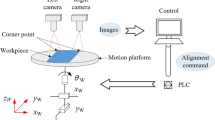Abstract
This paper discloses a method for simple and efficient optical coupling of a robotic arm with a tool with unknown location without exerting forces to the tool. Current solutions involve moving the robot in force-control mode and coupling by means of a manual gripper. This poses the problem with the transfer of unwanted forces to the tool while attempting to secure the design. With the intrinsic solution presented here, the camera is placed on the coupling axis and thence measures the distance and orientation to the target, the user will have the ability to safely guide the robotic arm towards the tool and smoothly couple the tool with the robot’s end effector. The mechanical prototype is not here described; this paper emphasizes the image processing, consequent data interpretation and general approach. After the explanation of the technique, its theoretical performance limit was examined and confirmed against the practically achieved performance.
Preview
Unable to display preview. Download preview PDF.
Similar content being viewed by others
References
Burgner, J., Zhang, Y., Eggers, G., Raczkowsky, J., Mühling, J., Wörn, H.: Semiautomatisches Ankopplungsverfahren für einen Assistenzroboter zur Repositionierung osteotomierter Knochenstücke bei orthognath-chirurgischen Eingriffen. In: Curac 2007, Pro BUSINESS GmbH, Karlsruhe, vol. 6, pp. 275–278 (2007)
Stolka, P.J., Henrich, D.: Using Maps from Local Sensors for Volume-Removing Tools. In: IEEE/RSJ International Conference on Intelligent Robots and Systems (IROS), San Diego (2007)
Furness, D.: System and method for precisely positioning a robotic tool. United States of America (1992)
Vieira, V.M.M., Eggers, G., Ortmaier, T., Kane, G.J., Marmulla, R.: Method for optically-controlled semi-automatic coupling of a robot arm with a surgical tool while maintaining sterile conditions. In: Curac 2008, Leipzig, pp. 127–130 (2008)
Luhmann, T., Robson, S., Kyle, S., Harley, I.: Close Range Photogrammetry - Principles, Methods and Applications. Whittles Publishing (2006)
Kanatani, K.: Geometric computation for machine vision, vol. 37. Oxford University Press, Inc., Oxford (1993)
Fiala, M., Shu, C.: Fully Automatic Camera Calibration Using Self-Identifying Calibration Targets. Institute for Information Technology, National Research Council of Canada, Ontario, 26 (2005)
Heikkilä, J.: Geometric camera calibration using circular points. IEEE Transactions on pattern analysis and machine intelligence 22, 1066–1077 (2000)
Tsai, R.Y.: A Versatile Camera Calibration Technique for High-Accuracy 3D Machine Vision Metrology Using Off-the-shelf TV Cameras and Lenses. IEEE Transactions on robotics and automation, RA 3, 323–345 (1987)
Gander, W., Golub, G.H., Strebel, R.: Least-Squares Fitting of Circles and Ellipses. Institut für Wissenschaftliches Rechnen, Eidgenössische Technische Hochschule, Zürich, Switzerland, Zürich (1994)
Stäubli RX90 specifications (October 08, 2008), http://www.servosystems.com/staubli_rx90.htm
Advancing measurement - with the complete wireless freedom of a FaroArm (October 08, 2008), http://measuring-arms.faro.com/distri/start/
Estaña, R., Wörn, H.: Moiré-Based Positioning System for Micro Robots. In: SPIE’s Int. Conference on Optical Measurement Systems for industrial Inspection III. Universität Karlsruhe, Deutschland (2003)
Author information
Authors and Affiliations
Editor information
Editors and Affiliations
Rights and permissions
Copyright information
© 2009 Springer-Verlag Berlin Heidelberg
About this paper
Cite this paper
Vieira, V.M.M., Kane, G.J., Marmulla, R., Raszkowsky, J., Eggers, G. (2009). Error Analysis of a Sub-millimeter Real-Time Target Recognition System with a Moving Camera. In: Köppen, M., Kasabov, N., Coghill, G. (eds) Advances in Neuro-Information Processing. ICONIP 2008. Lecture Notes in Computer Science, vol 5507. Springer, Berlin, Heidelberg. https://doi.org/10.1007/978-3-642-03040-6_70
Download citation
DOI: https://doi.org/10.1007/978-3-642-03040-6_70
Publisher Name: Springer, Berlin, Heidelberg
Print ISBN: 978-3-642-03039-0
Online ISBN: 978-3-642-03040-6
eBook Packages: Computer ScienceComputer Science (R0)




